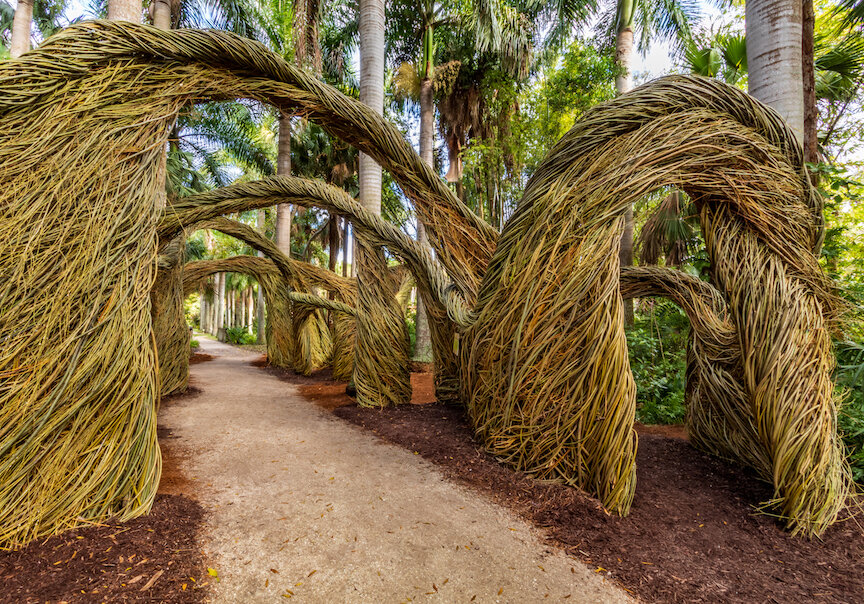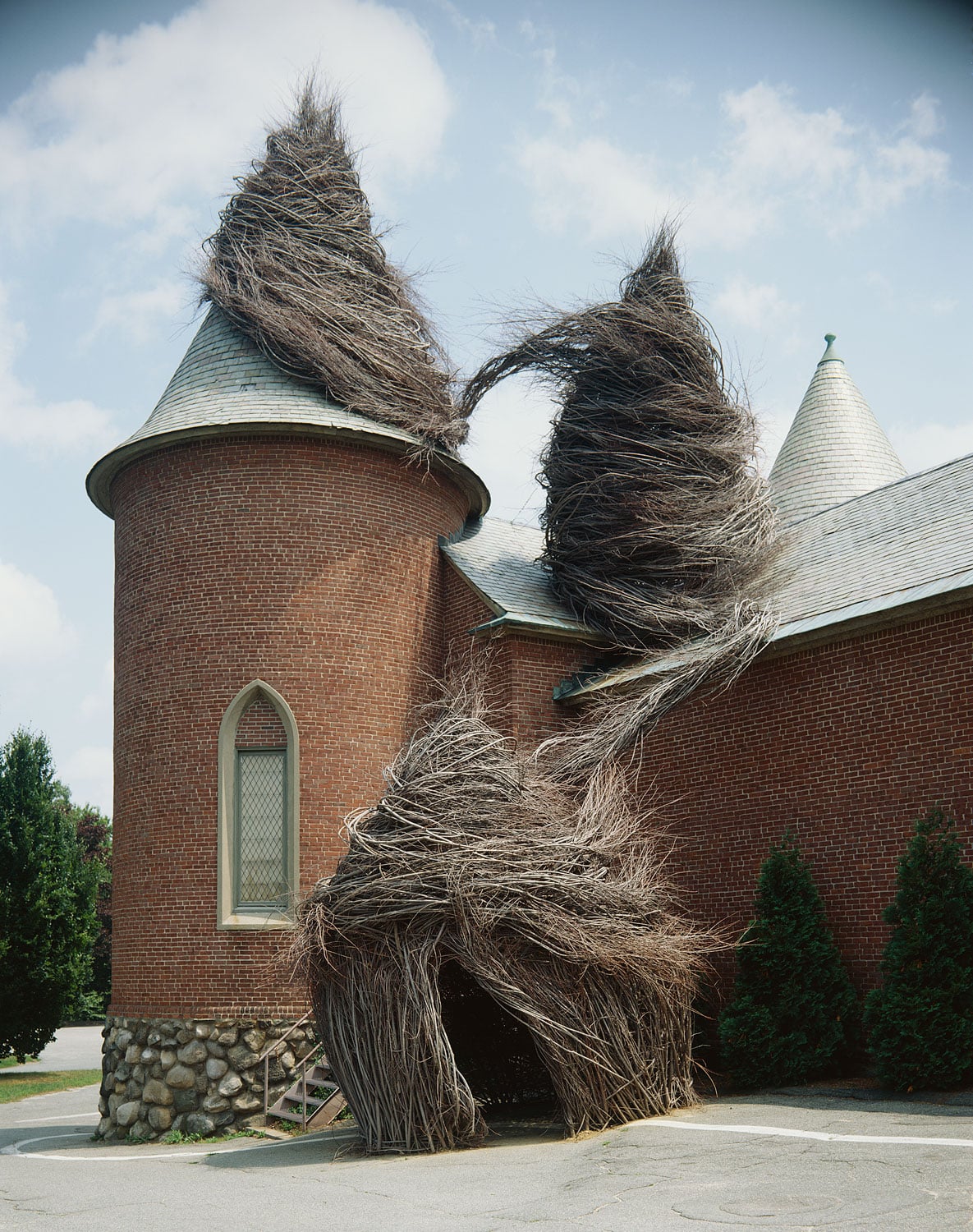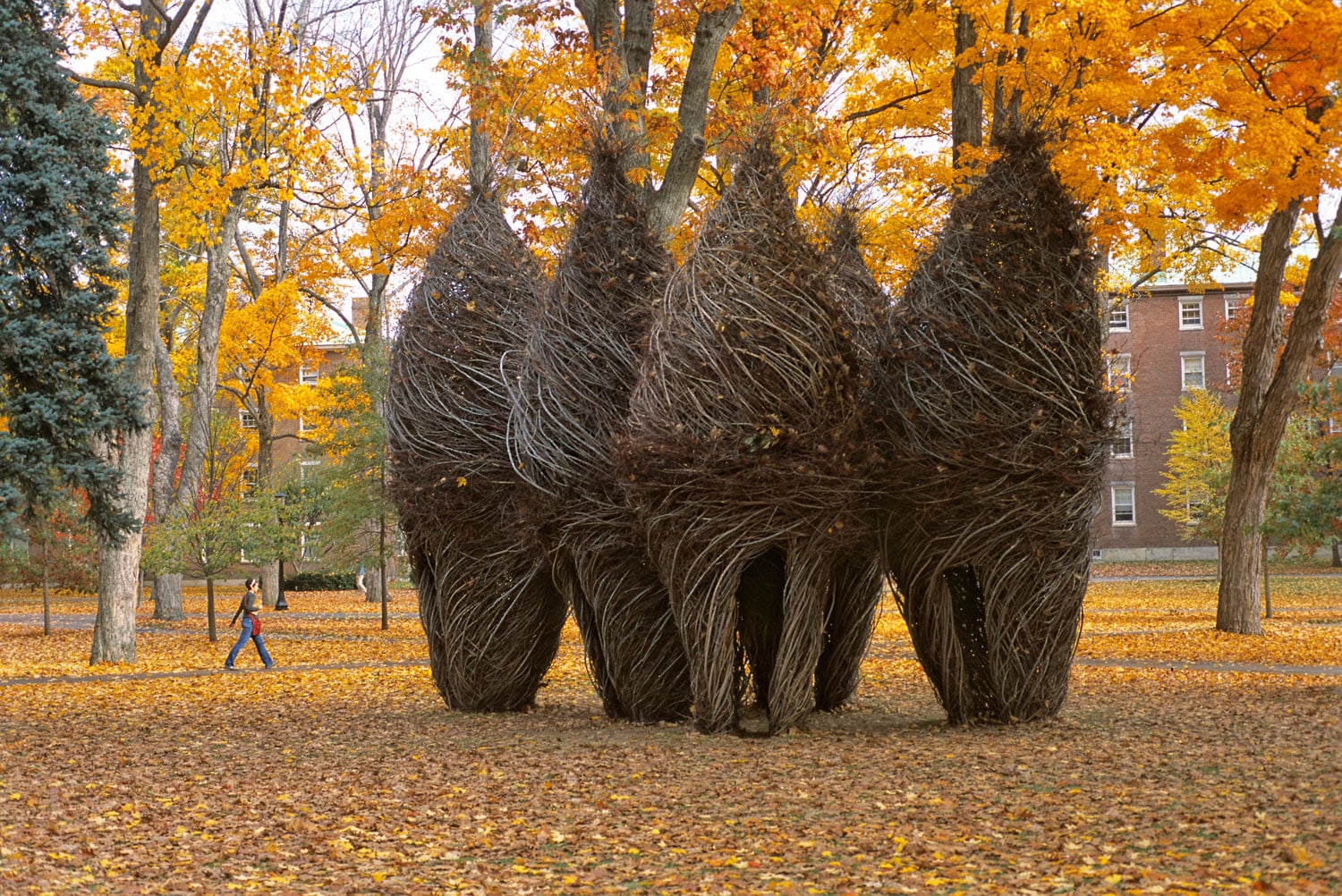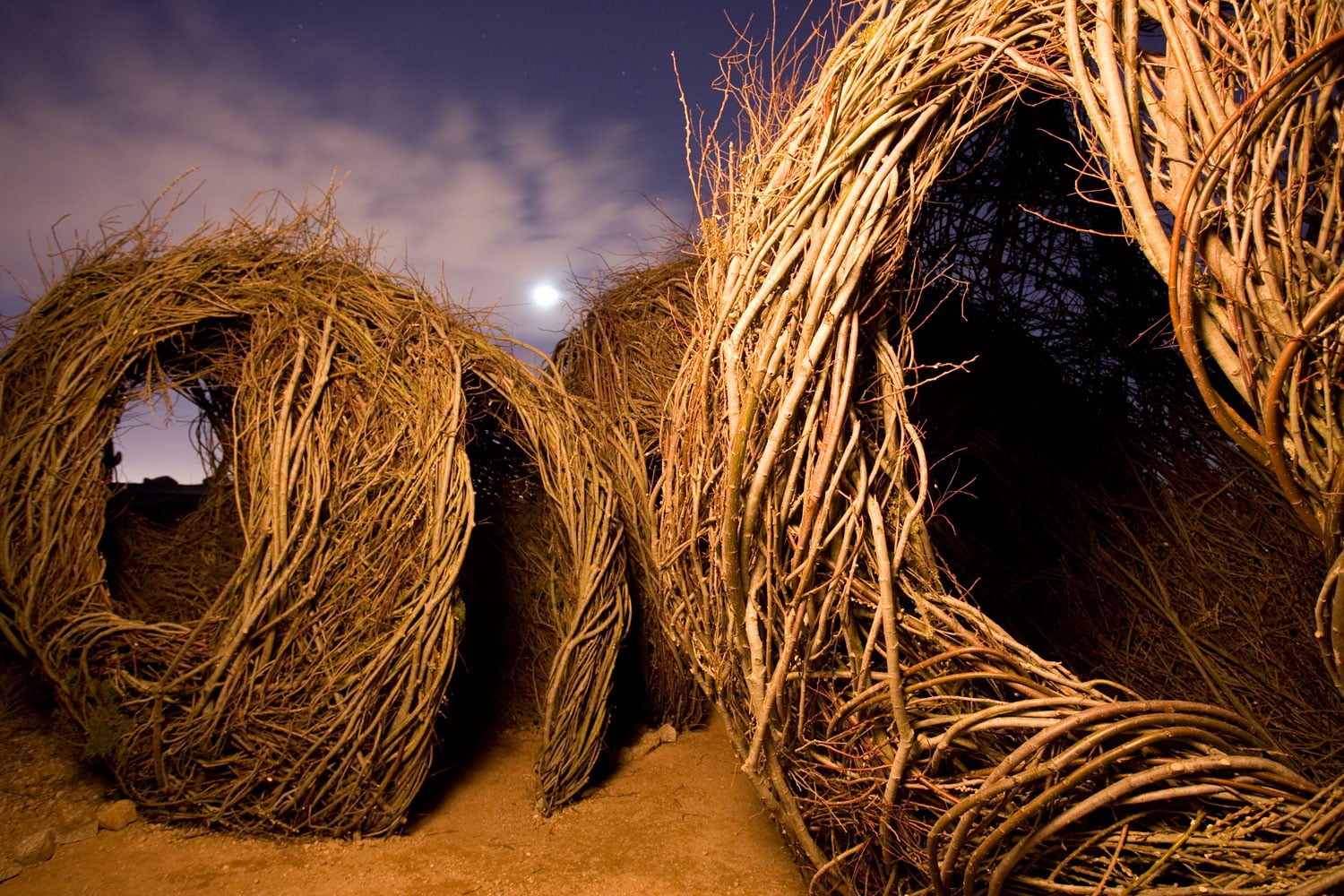Unlike most sculptors, Patrick Dougherty makes things that are meant not to last. And yet, a tremendous amount of work, hard physical work, careful planning, and artful imagination goes into every piece; each is a beautiful, collaborative rendition of an interaction between the artist, his material, and the natural and social environment. This impermanence cultivates joy—a feeling as powerful as it is ephemeral—and a sense of the wonder and fragility of the world.
Dougherty was raised in North Carolina, where he spent his childhood roaming the woods. Later, he combined his carpentry skills and love of nature to create art using saplings as a construction material. In this medium Dougherty has built over 330 enormous sculptures all over the world.
He has received numerous awards, including the 2011 Factor Prize for Southern Art, North Carolina Artist Fellowship Award, Pollock-Krasner Foundation Grant, Henry Moore Foundation Fellowship, Japan-US Creative Arts Fellowship, and National Endowment for the Arts Fellowship. Princeton Architectural Press published a book about his work in 2009, and Dougherty wrote a monograph, Stickwork, in 2010. You can see images of some of his work at www.stickwork.net.

‘Grand Central’, a piece in McKee Botanical Garden, Vero Beach FL in January 2020. Photograph by Bob Joy.
Dougherty and I sat outside his home in North Carolina in the fall of 2021, where a long lane of arcing bamboo leads to a lovely, rock-walled pond. I asked him questions about his art and principles of composition, and the contexts in which he produces and thinks about his work.
Helena Feder: We are sitting here next to the pond in the garden by the stone house that you built in the 1970’s. Did you use local materials?
Patrick Dougherty: When scouting for building materials, I saw the potential of the stones piled in the woods nearby. That style of foraging materials from immediate surroundings has become a mainstay of my work in the last thirty years. Gathering saplings along my driveway led me to discover the troves of saplings being cut to maintain roadways, power lines, and vacant lots. Urbanization has meant vast clearing efforts and I have had the opportunity to recycle a percentage of those small trees into compelling sculptures.
Looking at this wall around my pond, I like to imagine how a particular stone might roll from one generation to the next. A farmer clears land and stacks stone out of his way. The best ones are chosen for a chimney. In a hundred years, that stack falls down and it finds its way into my new wall.
HF: Were you influenced by the 1970’s revival of building one’s own home?
PD: My first career aspiration was to become a hospital administrator, and I spent two years at the University of Iowa and another three years in the Air Force pursuing that goal. In my early 30’s, however, I felt the “call of the wild” and gave up my day job to build a log cabin. Mother Earth News and the Foxfire books were definitely on my reading list. A career in sculpture dovetailed with building my own house, and soon I enrolled in the nearest art department. Ultimately, my administrative background came in handy too, in that producing large-scale onsite sculpture requires working closely with a sponsoring organization.
HF: If you had to articulate an ethic or set of principles for your work, how would you phrase it?
PD: In its early phase, “installation art” was hard to sell and galleries were generally not part of the equation. As a result, my artwork first developed outside the established art system. The work resonated with viewers and continued to grow in popularity on its own. As an untethered sculptor, I continued to mature and felt free to seek work independently.
Second, I have always made temporary work: work that has a life cycle. Like every good flowerbed, my work has a moment of glory but, ultimately, returns to the soil. I have always appreciated this process and I believe that impermanence draws the viewer into a more intimate relationship with the sculpture.
Finally, my work has always tried to engage the public. I work in the public eye without the benefit of doors one might close. I have come to see the viewer as critical to the dynamic of making. I am convinced that this constant contact with sponsors, volunteers, and audience has made me a more insightful and productive sculptor.
HF: I see: independence, impermanence, and public engagement. These are generative principles, and ones clearly reflected in your work. Are most of your pieces, then, both outdoors and open to the public?
PD: I build saplings sculptures in a variety of places both inside and out. Some of my sculptures have been intertwined with architecture; for example, a work made at the DeCordova Museum in Lincoln, MA. One element of the work capped the 70’ front tower, which connected to a second element on a lower roof and ended in a rude hut on the ground below. The concept alludes to a castle tower tumbling to its original form as a serf’s hut. Other sculptures have related to trees, and in a work in New Harmony, Indiana, branches were woven into a stand of hornbeam trees. The result was a group of circular elements, which gave the impression of a “cliff dwelling” made of twigs. Finally, we are often given a site where the work must stand on its own without the benefit of tree or architecture, and I have developed techniques which can produce freestanding towers, temples, bivouacs, and bowers.

‘Spinoffs’, a piece at DeCordova Museum and Sculpture Park in Lincoln, MA in 1990. Photograph by George Vasquez.
HF: You often say “we” instead of “I.” Although you do so much of this physical as well as aesthetic labor, your work involves a collaborative process of construction.
PD: My partnership with organizations includes their aid in recruiting volunteers to help with the collection of saplings as well as the weaving work. Having volunteers working helps to imbed the work into the community, but it also makes construction more fun. I get to know something about the area and the people who live there. I imagine that the energy of the volunteers and the site is somehow woven back into the finished piece itself. Many of our volunteers have incredibly interesting lives and, if we’re lucky, will share a few far-fetched tales as we work. At the end of the workday, it’s easy to say “we.”
And, since 2016, my son Sam has been my full-time assistant and has added great expertise to our “we.”
HF: Are the raw materials part of this “we” as well? Do you ever alter the sticks?
PD: I am fond of all the natural color variations in the saplings I find and sometimes use color change to bring emphasis to some part of a sculpture. For example, sycamore saplings which are white tend to contrast well with cherry branches which are darker. I do cut sticks to various lengths and might use the shafts in one way and the brushy tops in another. My goal is to pick up a sapling and to try to enhance the surface I am working on. I try for a luxurious surface with depth and a variety of line sizes. I work hard to bring a kind of “line logic,” that is, to build an impression that lines flow along the outer surface and then spill gracefully into one door and out a nearby window. The result is an object that mimics the air and water currents found in the natural world.
HF: Yes, almost like natural, found objects, though they’re clearly complexly constructed works. Your pieces offer viewers such a fluid experience, one that makes the sculptures themselves seem light and easy.
PD: My job is to build a credible illusion that the viewer finds pleasurable. Part of that is to impart a sense of freedom and carefree movement to the surface. I try to build a piece that doesn’t look human-made, that suggests a more organic origin. In part, I use drawing techniques and the magic of line to lighten the sculptures and to avoid a belabored appearance.
As far as the actual build, there is an element of play in the construction process, but in reality, it’s a bit like a contact sport. My assistant and I, along with our volunteers, work eight hours a day, and try to keep the pressure on. We dig holes, set scaffolding, and hoist planking all day. More important, we constantly flex and bend saplings—thousands of saplings of all sizes, providing an upper body workout to rival a gym.
HF: At your Smithsonian talk in 2016, you said that you’re “an inspiration builder.” This phrase turns two ways. One describes method, and one describes object.
PD: You know, I try to approach a prospective site without preconception. I try to remember how I “feel” when I first see it. I ask myself what I could do with this particular set of circumstances that I could not do anywhere else. My first impression is a moment of imminent possibility. Several ideas usually emerge, and I try to problem-solve how I could best bring one idea to fruition.
That is the method of discovery, but the actual build also requires a kind of open-ended thinking. Generally, I will establish some parameters for the work, using words to describe how the sculpture should transform the space. As the work begins, I establish precedent for working with the particular load of saplings the crew has gathered. Long limber sticks might build one kind of work; short branches with staccato ends might build another. Just as a fine artist might paint in some base color and then react with further strokes, I constantly study the surface and try to react in a way that results in a provocative and lavish surface.
Working at the Kohler Art Center in Sheboygan, WI, in 2000 is a good example of dreaming up a work, and then maximizing the effect during the build. The art center’s new garden sat on the leading corner of the lot and included a fragment wall of the old post office which once stood there. I decided to make a sapling version of Rome’s Temple of Saturn. In this case the temple would straddle the old post office wall in such a way that the temple core was both inside the garden and on the exterior by the street. The weather was cold and wet, and, on a whim, I stuck the bundles of saplings for the fluted columns down in the mud. As spring progressed, the whole structure—columns and roof—leafed out with a frenzy of green, giving the impression of a living building.

‘Simple Pleasures’, a piece at Bowdoin College Museum of Art, Brunswick, ME in 2001. Photograph by Bowdoin College.
HF: For many reasons, your art seems more public than most. Does your work reflect public concerns?
PD: I try not to overload my work with strident fervor, but something ecological is always present. Saplings and the forest they come from reach into people in a subtle way. Memories of a favorite childhood climbing tree might bubble up as a person walks within. Or perhaps the sculpture triggers a memory of jumping the creek during an autumn hunting trip. A viewer’s fantasy also plays into the encounter. I hear about wishes for a day in the Garden of Eden where, unencumbered with worldly possessions, one can talk to the animals. All of these touchstones form a canvas on which a raft of feeling already rests. I work in a poetic way, building from all of the associations people have. After all, the human subconscious is a vast reservoir.
HF: I love it that you use the word “poetic.” Do you have any favorite terms or metaphors for your work?
PD: Of course, I have heard every stick joke and play on words that include stick, branch, or twig. However, I have formally settled on the word “sapling.” Since I think of saplings as lines with which to draw, I use drawing terms like crosshatching and raking diagonals and I encourage small bent lines along the bottom of the sculpture which I call “lifts”. I also have a number of speed terms in my lexicon because I imagine a flowing, moving, jumping, or cascading surface. As far as metaphors, they abound.
HF: What kind of artwork intrigues you?
PD: Well, truthfully, I would like a Thomas Cole painting in my living room, so that I could enjoy his bucolic view of the natural world. Nor can I forget my forbearers: sculptors like Robert Smithson, Nancy Holt, Michael Heizer, Richard Long, David Nash, Andy Goldsworthy, Chris Drury—there are so many sculptors who have worked well with nature that I could cover at least a couple pages with names, single spaced. On a personal level, I would shake the hand of anyone brave enough to gather up a bit of the material world and make a sculpture. It takes courage, but the feelings it engenders can be life changing. I have had a wonderful career as a sculptor and would encourage anyone to take the plunge.
HF: The first piece of yours I walked inside was at the North Carolina Botanical Gardens. I was with my son, who was quite little at the time, and we chased each other in and out of the piece.
PD: I am really glad you and your son were able to extend the mystery of hide-and-seek. Even when constructing with saplings, the formal aspect of line and form are important, but I also believe that a good sculpture should cause numerous other associations in the viewers. Someone might remember a bird’s nest, a walk in the woods, or the first kiss under a lilac bush. Children’s association with sticks seems to be about utility; for them, a stick can be a weapon, a tool, a magic wand, or a segment of wall.
HF: You’ve told me you recently built a sculpture in a park in Detroit, MI. How did that work out, and were you able to find local materials in the city itself?
PD: Yes, I was sponsored by the non-profit Sidewalk Detroit, part of a trend of grassroots organizing in Detroit. Sidewalk Detroit hopes to energize Eliza Howell Park with concerts and art exhibits, and their current effort has been along environmental themes. My sculpture was situated on the front edge of the park where all roads converge, with the hope of encouraging passing drivers to park and have a look. The saplings were gathered by my crew in out-of-the-way areas in several local parks and trucked to the site. The sculpture had a nest-like quality with many openings and surprising twists and turns. The local African American community turned out for the opening in large numbers. A local minister who had doubts about the project on initial discussion delivered the best of compliments as local residents streamed through: “This is community. I just had no idea that something made of sticks could turn out this way.”
HF: That is a wonderful compliment and leads to my next question. How do you see sculpture itself fitting into, or changing, social life?
PD: Your question brings to mind how someone can be sure he/she is a sculptor, be sure he/she is the “real thing.” I imagine that in urban areas, sharing ideas with other artists might be easier. Perhaps a novice could belong to an artist-run space or engage in art discussions at the corner bar. But North Carolina has a very diffuse art scene, and it takes an effort to travel from one art outpost to another. When you leave school, there is no art welcoming committee, and it takes persistence to organize an art life and find like-minded souls. For me, in the early years in Chapel Hill, NC, I felt uncertain about the relevance or contribution my sculpture could make. But along and along, I had an epiphany: It must be worthy to build work that brings viewers to a new level of awareness. I slowly admitted that indeed, I was the real thing.
Lately, working in Detroit, I became envious of the groundswell of art and sculpture in that city. There seems to be energy in desperation and some sculptors have used the materials of decay to create compelling work. I was impressed with a three-story building with thousands of broken mirrors glued to the outside, decrepit but glittering like a new toy. I wondered how my own sculpture path would have developed in such a world.
In the bigger picture, all humankind has begun to worry about the planet and climate change, and my sculptures from saplings have been celebrated by this new awareness. In Europe, you hear monikers like nature-based art, land art, and environmental art; there, the relationship between art and nature has been fostered by a number of sculpture parks which champion this kind of work. Examples include Krakamarken in Denmark, Grizedale Forest in England, and Arte Sella in Italy. I have been lucky to work for many of these institutions. In the United States, arboretums, forests, and gardens took up the mantle and began to invite artists who worked with the intersection of art and nature to integrate sculpture into the setting of trees and flowers. I have worked extensively for these organizations, and my work has been welcomed in Philadelphia, Cleveland, Cincinnati, Montreal, and hundreds of other great towns and cities across the world.
HF: You have talked about working in public, but do you consider yourself part of the public art initiatives that many cities and institutions have launched?
PD: Many public entities do announce calls for artists, engender panels, and select artists for work in plazas and related spaces. I have tended to work for institutions who commission me directly and who have a relationship with a specific “public,” not the general population; for example, arboretums, universities, museums, and art centers. Generally, these organizations use the sculpture to build attendance and, in that regard, the work may attract press and ultimately become a destination for the wider community.
In developing a work for a particular sponsor, it is important first to understand the audience and second to understand how the space is used and then to make a plan that activates the space in an unexpected way. Lately we worked for Maryland Hall in Annapolis, MD. The converted high school has been refurbished as a credible performing art center with a huge community following.
The green space in front of the building was designated event space, which left little room for a sprawling sapling sculpture. However, on one leading edge of the building was a huge elm tree whose spread of limbs suggested a magically natural alcove. The massive tree became the core of my design, and, in the finished work, woven elements of the sculpture vaulted through the upper branches and settled into four circular segments nestling the massive trunk. Not only did concertgoers explore the sculpture, but also many commented they had never noticed this magnificent tree before.
In talking about patrons of a space, I always try to acknowledge the “unrecognized and overlooked viewers” and take their sensibilities into account as well. I am speaking of maintenance and service workers, the UPS guy, the neighbors who drive by, and the morning dog walkers. A successful sculpture needs to appeal to the hundreds of unacknowledged viewers as well to seasoned art lovers. During my time at Maryland Hall, a street repair was in progress. I caught the concrete crew by surprise and invited all of them to come and walk through the sculpture. They promised to bring their kids and left laughing about the possibilities of a “stick road.”
HF: Many of your works have rooms or windows that beautifully channel light. Given your attention to overlooked audiences, I wonder about those senses sculpture has often overlooked in the past. Do you also consider sound or smell?
PD: Different species offer their own unique odors: that is, cherry smells one way, maple smells another, and this enhancement does subtly place the viewer in a wilderness frame-of-mind.
I do have a story about smell. In 1993, I worked at the Phillips Collection in Washington, DC. I was constructing a sculpture that occupied the central barrel of the three-story circular stairway. I described it as a three-story tower. To reach the highest point, I was working from a scissors lift inside the tower. One day, as I worked high on the upper reaches, I heard someone below enter the construction and discretely pass a great quantity of gas, as all humans do. The sculpture smelled to high heaven, and that aroma overwhelmed any freshness the sticks themselves might carry. I thought I would have to abandon my post or pass out. Before I could act, another group of viewers entered the sculpture below. Instead of running away, someone in the group, exclaimed “Oh My God! Can you believe the sweet smell of nature?!” [Laughter]
HF: That is funny … and, indeed, a smell of nature (including some nonhuman sculptures). Do you derive inspiration from nonhuman builders?
PD: In 2009 I worked at the Spencer Museum at University of Kansas. Simultaneous with my sculpture installation was a display on weaverbirds and their nest-building activity. With my knowledge of the properties of saplings, I was able to appreciate their craftsmanship and understand their process. Their consistent placing of the base of a stick down and the branchy end up made structural sense, and the lightness at the top of their nests hinted at a kind of freedom. After seeing their effort, it was clear to me that what humans see as beauty has something to do with intentional and purposeful repetition.
On the other hand, it’s hard to believe that some bird species survive. I worked in a park in downtown Charleston, SC in 1997, within a grove of live oak trees where the night herons were nesting. It was clear after only a day that I made a far better nest than this group of birds. A night heron lays three of four sticks together precariously on a limb and then plops an egg haphazardly on this paltry arrangement of twigs. It only takes a few minutes before a passerby gets a surprise egg for breakfast and screams “those damn birds!” Eventually I was warned, “You gotta be really careful of the night herons; they bomb everybody in the park. You don’t want to get egg on your face. Ha ha.”
HF: You’ve said that you don’t try to imbue your work with meaning in a way that’s prescriptive. However, the way in which you think about audience professes a democratic politics, and about nature an ecological politics.
PD: I have always believed it more productive to follow your inklings and nuanced feelings than it is to worry about how a sculpture will fit into the lifeline of history. Creativity often capitalizes on misadventure, a mistake, or a misstep and only later does it register that the accident was a crucial starting point for the best work.
In my mind, sculpture is transportive and gives the viewer an opportunity to identify new feelings. A provocative sculpture touches the sensibilities of the fine art painter AND the house painter who is working next door. It is one that enlivens and provides an enjoyable experience for those of all ages. Children run through; oldsters just imagine they could. Part of my mission is beauty, and part is to create sculpture that rises above politics and social power to become a touchstone for everyone who happens by.



